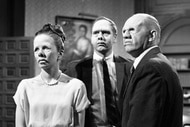Create a free profile to get unlimited access to exclusive videos, sweepstakes, and more!
Nebulaaaaaaarrrrrrrrrr

Hey, it’s Halloween! Yes, today is the Internet’s favorite holiday, right after Pi Day, Mole Day, Star Wars Day, and, of course (oooo, foreshadowing), Talk Like a Pirate Day.
I enjoy finding creepy astronomical photos to post on Halloween; it's generally not too hard to find something since a) humans are really good at imagining faces in things like clouds, 2) clouds are abundant in space, and γ) the uncanny valley is a pretty wide when it comes to distorted faces skeeving people out.
One image came across my bow recently that not only fulfills these requirements, but when I dug deeper I found it does a better job than I expected.
Bonus: It has a Halloweeny name.
Presenting the Skull and Crossbones Nebula!
That gorgeous image shows NGC 2467, a gas cloud roughly 20,000 light years away that’s busily birthing stars. It was taken using the aptly (if somewhat prosaically) named Very Large Telescope in Chile.
The red glow is hydrogen gas, warmed and excited by ultraviolet light blasting out from very young, very massive, and very energetic stars inside the nebula. One star system, HD 64315, dominates both the image and the nebula itself; it’s apparently a quadruple star (two pairs of binary stars orbiting each other) with a combined mass of more than 90 times the Sun!
Each star is a powerhouse, pumping out so much energy that the gas around it is expanding away from it, slamming into much colder, denser gas around it. You can see that along the bottom of the red gas as a bright ridge of material, like a mountain range someone forgot to paint the bottom of. Denser knots of colder material appear in silhouette, dark blobs that may be cocoons for stars forming inside them.
So why is this called the Skull and Crossbones Nebula? It took me a moment to see it, but it’s actually kinda cool. The Skull is made up of the two blue eyes near the top (surrounded by darker dust, looking like eye sockets), a nose of HD 64315, and a slightly puckered, almost heart-shaped mouth. The sharp ridge makes up the Crossbones, since it bends upwards to the right and left, and there’s a hint of an X in the middle (which in part forms the mouth).
As I looked at this image, I kept thinking this nebula looked familiar, and as I poked around looking for references I found this image, which honestly is way, way more spooky:
Yikes! It’s a glaring alien monster!
This is a much wider field of view than the image above. NGC 2467 is the lower part of this face (note this image is rotated about 90° counterclockwise to the first one), with a star (called HD 64455) marking the eye on the left and a small cluster of stars called Haffner 19 exciting a sphere of gas (called a Strömgren sphere) marking the eye on the right. The mouth of this face looks vertical, an insect-like mandible. Creepy.
The colors are different because different filters were used for the second image — filters select out different colors of light, and these are emitted by different elements in the gas, like hydrogen, oxygen, and sulfur. That means we also see changes in the structure, on top of the fact that the telescope used for the second image — the 2.2-meter MPG/ESO telescope — is much smaller than the 8-meter diameter of the Very Large Telescope, so the resolution is different as well.
In astronomy, as in life, what you see depends on how you see it. And while the idea that this looks like a skull-and-crossbones pirate flag is subtle, I have to admit that I found some humor in where in the sky this nebula is located: the constellation Puppis… the Poop Deck! Yes, seriously, the constellation is named after part of a ship (along with Vela, the sails, and Carina, the keel, which used to be part of one big constellation called Argo Navis, the ship Argo). Perfect.
So whether ye a pirate be, or an alien hunter, or just an astronomy nerd like me who loves a good excuse to look at a gorgeous cloud of gas and dust:
Happy Halloween!



























